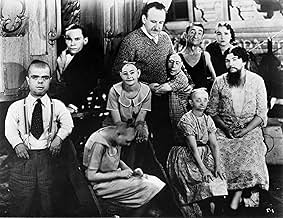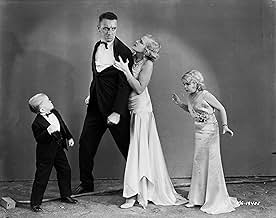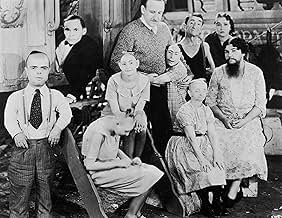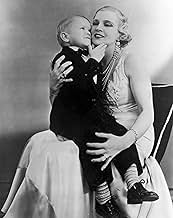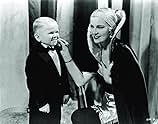NOTE IMDb
7,8/10
53 k
MA NOTE
La belle trapéziste d'un cirque accepte d'épouser un des artistes du spectacle, mais ses amis difformes l'avertisse qu'elle n'est intéressée que par son héritage.La belle trapéziste d'un cirque accepte d'épouser un des artistes du spectacle, mais ses amis difformes l'avertisse qu'elle n'est intéressée que par son héritage.La belle trapéziste d'un cirque accepte d'épouser un des artistes du spectacle, mais ses amis difformes l'avertisse qu'elle n'est intéressée que par son héritage.
- Réalisation
- Scénario
- Casting principal
- Récompenses
- 2 victoires et 1 nomination au total
Roscoe Ates
- Roscoe
- (as Rosco Ates)
Prince Randian
- The Living Torso
- (as Rardion)
Avis à la une
In the first place, this movie was originally made to compete with the Universal Horror films, as though these human beings who are the titular "freaks" are not human. Director Tod Browning was still reeling from the loss of his big star, Lon Chaney, to cancer, and thought this would be a good follow up to his previous horror films without Chaney. And after all, he had just finished directing Dracula.
Actually, it paints a very sympathetic picture of the disabled and deformed circus performers, who, at this time of limited medical knowledge and abounding prejudice, were very limited in what they could do in life. They have a very deep camaraderie that is shown through such events as the birth of a child to the bearded lady and the engagement of one of the conjoined twins. Since the other twin is already married, there is much arguing over what the logistics are going to be in these two marriages.
The actual "monsters" in this film are the acrobat "Cleopatra" (Olga Baclanova), and strong man Hercules (Henry Victor), who are having an affair. Two physical specimens with monstrous morality. When the dwarf Hans is captivated by Cleopatra's beauty, she at first teases him by leading him on. But then he starts giving her expensive jewelry and she decides to keep up the ruse. When Freida, Hans' dwarf girlfriend, comes to Cleopatra and asks her to stop teasing him, she accidentally tips off Cleo to the fact that Hans has inherited a great fortune. Hercules and Cleo then plan to get Hans to marry Cleo and then poison him so she can inherit his money. But the two don't realize the close strong bond that the circus performers have with one another and that they are literally each others eyes and ears. Complications ensue.
The film was originally set to run at 90 minutes, but test audiences were so revolted that 30 minutes were cut out so that the remaining film only runs at an hour. Then a scene was tacked on at the end to show Hans' grief over what has ultimately happened. MGM would often add an end scene that really didn't fit the mood of the rest the film during Irving Thalberg's reign there to wrap things up.
This film pretty much finished the career of director Browning as afterwards he only directed a farcical sound remake of a silent film he had made at MGM and one other film and then retired. This was a good late role for Olga Baclanova. She had a very thick Russian accent and had some great late silent roles at Paramount, but talking film had not been kind to her career. This really gave her one last great role where her accent really fit into the plot, plus this was not a film where lots of dialogue was called for, and she was very good at using gestures and expressions to convey emotion.
In the 1960s this film got a fresh look, and today is widely celebrated as having been ahead of its time. The horror is implied and left up to your imagination as to just HOW it happened, and the empathy shown the circus performers is profound. It even got a separate DVD release with commentary.
Actually, it paints a very sympathetic picture of the disabled and deformed circus performers, who, at this time of limited medical knowledge and abounding prejudice, were very limited in what they could do in life. They have a very deep camaraderie that is shown through such events as the birth of a child to the bearded lady and the engagement of one of the conjoined twins. Since the other twin is already married, there is much arguing over what the logistics are going to be in these two marriages.
The actual "monsters" in this film are the acrobat "Cleopatra" (Olga Baclanova), and strong man Hercules (Henry Victor), who are having an affair. Two physical specimens with monstrous morality. When the dwarf Hans is captivated by Cleopatra's beauty, she at first teases him by leading him on. But then he starts giving her expensive jewelry and she decides to keep up the ruse. When Freida, Hans' dwarf girlfriend, comes to Cleopatra and asks her to stop teasing him, she accidentally tips off Cleo to the fact that Hans has inherited a great fortune. Hercules and Cleo then plan to get Hans to marry Cleo and then poison him so she can inherit his money. But the two don't realize the close strong bond that the circus performers have with one another and that they are literally each others eyes and ears. Complications ensue.
The film was originally set to run at 90 minutes, but test audiences were so revolted that 30 minutes were cut out so that the remaining film only runs at an hour. Then a scene was tacked on at the end to show Hans' grief over what has ultimately happened. MGM would often add an end scene that really didn't fit the mood of the rest the film during Irving Thalberg's reign there to wrap things up.
This film pretty much finished the career of director Browning as afterwards he only directed a farcical sound remake of a silent film he had made at MGM and one other film and then retired. This was a good late role for Olga Baclanova. She had a very thick Russian accent and had some great late silent roles at Paramount, but talking film had not been kind to her career. This really gave her one last great role where her accent really fit into the plot, plus this was not a film where lots of dialogue was called for, and she was very good at using gestures and expressions to convey emotion.
In the 1960s this film got a fresh look, and today is widely celebrated as having been ahead of its time. The horror is implied and left up to your imagination as to just HOW it happened, and the empathy shown the circus performers is profound. It even got a separate DVD release with commentary.
"Freaks" is one of the most controversial horror films from the 30's,mainly because director Tod Browning hired as the actors real sideshow freaks.It does have a rather unsettling effect,but I think that really does work for the film.Browning builds up a great amount of suspense with the good use of locations,story and lots of atmosphere.The ending,where we see freaks crawling in the mud,is pretty creepy.Anyway check this one out-it's worth watching.
It's interesting to me that this film is viewed as offensive. People say that these people are being made fun of and exploited. I wouldn't like to comment on how they were treat on set or anything but I will say that they all see to enjoying them selfs for the most part and as for being made fun of, I think the total opposite is happening.
This movie came out in 1932 so before I watched it I also was nervous that these people would be used to make others laugh at their expense but it was the furthest thing from the truth. This film hands its subject matter with such care and deft that I was astounded that it came out in 1932.
It can be like looking at window into the past as sometimes it almost plays like a documentary due to the fact that most of these actors were actually circus performers. There are so many scenes where the performers are just relaxing and chatting to each other. It shows people they are just like us, it doesn't mater if they look different. It shows them doing mundane things like hanging washing, struggling with problems like infidelity. It shows ignorant people that they are human just like you.
I think the title "Freaks" is interesting. I think there is two ways to look at it. The first way is the obvious and offensive way demeaning the performers but I think by the end of the film the only freaks in this movie are the people who look normal. The movie shows this makeshift family coming together for each other, the only people who are outcasts are the able bodied "normal people". I think that is one way to interpret it any way or maybe I am reading into it.
That is the interesting thing about this movie. You can read a lot into it and it is never clear what the director was really trying to say as another interesting part is all of the performers are shown to be good people, kind people for the most part friendly and loving. Once again the only truly evil people in this movie are the people who are able bodied people. The reason I lean to the side of the director was showing these people are simply just people is it is framed as shocking and wrong when bad things happen to the performers and I don't think it is ever played for laughs.
It also really bothers me that this movie is labelled a horror movie. It is a drama. There isn't really any horror elements to be found.
One more thing I just want to point out is that I am astounded how much Ryan Murphy took from this movie for season 4 of American Horror Story. Like I think his only reference point for "freak shows" was this movie. Just a stray observation.
So I would say definitely watch this movie. It is only short as it was cut down due to the fact people believed it was too outrageous and offensive. It has a lot of heart and is really head of it's time.
This movie came out in 1932 so before I watched it I also was nervous that these people would be used to make others laugh at their expense but it was the furthest thing from the truth. This film hands its subject matter with such care and deft that I was astounded that it came out in 1932.
It can be like looking at window into the past as sometimes it almost plays like a documentary due to the fact that most of these actors were actually circus performers. There are so many scenes where the performers are just relaxing and chatting to each other. It shows people they are just like us, it doesn't mater if they look different. It shows them doing mundane things like hanging washing, struggling with problems like infidelity. It shows ignorant people that they are human just like you.
I think the title "Freaks" is interesting. I think there is two ways to look at it. The first way is the obvious and offensive way demeaning the performers but I think by the end of the film the only freaks in this movie are the people who look normal. The movie shows this makeshift family coming together for each other, the only people who are outcasts are the able bodied "normal people". I think that is one way to interpret it any way or maybe I am reading into it.
That is the interesting thing about this movie. You can read a lot into it and it is never clear what the director was really trying to say as another interesting part is all of the performers are shown to be good people, kind people for the most part friendly and loving. Once again the only truly evil people in this movie are the people who are able bodied people. The reason I lean to the side of the director was showing these people are simply just people is it is framed as shocking and wrong when bad things happen to the performers and I don't think it is ever played for laughs.
It also really bothers me that this movie is labelled a horror movie. It is a drama. There isn't really any horror elements to be found.
One more thing I just want to point out is that I am astounded how much Ryan Murphy took from this movie for season 4 of American Horror Story. Like I think his only reference point for "freak shows" was this movie. Just a stray observation.
So I would say definitely watch this movie. It is only short as it was cut down due to the fact people believed it was too outrageous and offensive. It has a lot of heart and is really head of it's time.
The subject of human disability is still a taboo subject in Cinema, even over 70 years since this film's release.
It's difficult to imagine what impact this film would have had in the 1930's, but as it still has the ability to shock ( through the images of bodily deformity ) I can understand why many shunned and disowned this work, and why it totally ruined Todd Browning's film career.
The basic premise - that beauty is more than skin deep - can appear to be wielded with a sledgehammer, but perhaps the contemporary audience needed to be hit harder in order to make them understand the point.
The film is short ( due to enforced cuts ), and at times can move rather slowly and can appear rather 'stagey' which is a trait of many films from the 20's / 30's.
But don't let that put you off. The plot is simple, but it's the telling of the story rather than the story itself that is important. And you really do need to remind yourself that these are real people - not actors - and this was the live they led.
I rate it 9 outa 10 because they really don't make them like this any more.
It's difficult to imagine what impact this film would have had in the 1930's, but as it still has the ability to shock ( through the images of bodily deformity ) I can understand why many shunned and disowned this work, and why it totally ruined Todd Browning's film career.
The basic premise - that beauty is more than skin deep - can appear to be wielded with a sledgehammer, but perhaps the contemporary audience needed to be hit harder in order to make them understand the point.
The film is short ( due to enforced cuts ), and at times can move rather slowly and can appear rather 'stagey' which is a trait of many films from the 20's / 30's.
But don't let that put you off. The plot is simple, but it's the telling of the story rather than the story itself that is important. And you really do need to remind yourself that these are real people - not actors - and this was the live they led.
I rate it 9 outa 10 because they really don't make them like this any more.
D-U-M-B! Everyone's accusin' me!
I've been listening to The Ramones' music off and on for almost 30 years now, and despite reading and viewing tons of stuff about the band and its origins, I'd never run across how they came up with the whole "pinhead" theme.
Well, I've finally seen FREAKS, often listed as one of the great cult flicks of all time. And wouldn't you know it, the "pinheads", including "Schlitze", the inspiration for The Ramones' mascot who always came out to join the band during their live shows at the end of the Pinhead song, were in FREAKS.
The Ramones also slightly modified the "freak chant" from the wedding scene, changing "Gooble-Gobble" to "Gabba-Gabba". I guess Jeffrey Hyman (Joey Ramone) must have viewed himself as somewhat "freakish" (he did have an incredible look), and really related to the group of circus curiosities assembled for this film.
After being shelved for about three decades, FREAKS started playing again at art-house theaters in the mid-60's, and that's where Joey had to have come across it.
As far as my film review, this movie needs to be viewed. Look past the stilted acting, and soak up the message. It will stay with you for a long, long time.
I've been listening to The Ramones' music off and on for almost 30 years now, and despite reading and viewing tons of stuff about the band and its origins, I'd never run across how they came up with the whole "pinhead" theme.
Well, I've finally seen FREAKS, often listed as one of the great cult flicks of all time. And wouldn't you know it, the "pinheads", including "Schlitze", the inspiration for The Ramones' mascot who always came out to join the band during their live shows at the end of the Pinhead song, were in FREAKS.
The Ramones also slightly modified the "freak chant" from the wedding scene, changing "Gooble-Gobble" to "Gabba-Gabba". I guess Jeffrey Hyman (Joey Ramone) must have viewed himself as somewhat "freakish" (he did have an incredible look), and really related to the group of circus curiosities assembled for this film.
After being shelved for about three decades, FREAKS started playing again at art-house theaters in the mid-60's, and that's where Joey had to have come across it.
As far as my film review, this movie needs to be viewed. Look past the stilted acting, and soak up the message. It will stay with you for a long, long time.
Le saviez-vous
- AnecdotesThe on-screen romance between Hans and Frieda was very subdued because the roles were being played by real life brother and sister Harry Earles and Daisy Earles.
- GaffesAt 43:40 when Cleo tosses the wine at Angeleno, she is standing in front of him, but the wine she throws comes from the far right side of the frame.
- Citations
Freaks: We accept you, one of us! Gooble Gobble!
- Versions alternativesReissue prints included a two-and-a-half minute written prologue about historical interpretations and contemporary studies of "misshapen misfits." These same prints remove the MGM Lion (the studio having disowned the film for many years).
- ConnexionsEdited into Histoire(s) du cinéma: Le contrôle de l'univers (1999)
Meilleurs choix
Connectez-vous pour évaluer et suivre la liste de favoris afin de recevoir des recommandations personnalisées
Détails
Box-office
- Budget
- 310 607 $US (estimé)
- Montant brut mondial
- 4 072 $US
- Durée1 heure 4 minutes
- Couleur
- Rapport de forme
- 1.37 : 1
Contribuer à cette page
Suggérer une modification ou ajouter du contenu manquant

Lacune principale
What is the Japanese language plot outline for Freaks, la monstrueuse parade (1932)?
Répondre

